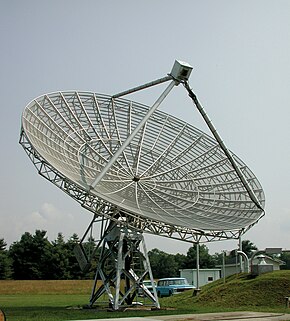40-foot radio telescope
 | |
| Part of | Green Bank Observatory |
|---|---|
| Location(s) | Green Bank, Pocahontas County, West Virginia |
| Coordinates | 38°26′14″N 79°49′53″W / 38.4372°N 79.8314°W |
| First light | 14 December 1961 |
| Telescope style | radio telescope |
| Diameter | 40 ft (12 m) |
| | |
The 40 Foot Telescope is a radio telescope at Green Bank Observatory, in West Virginia, USA.
Specifications
The radio telescope has a diameter of 40 feet (12 m). It is made of aluminium. It only moves in elevation, not in azimuth. It observes between 1340 and 1580 MHz[1]
History
The 40 foot was ordered in 1961 from Antenna Systems.[1] It was delivered in December 1961,[2] and took two days to assemble. Its first light was on 14 December 1961. The original control system was constructed by NRAO. On 1 February 1962 it became the first telescope to be fully automated.[1]
It was originally used to observe eight variable radio sources on a daily basis over the course of five years. The sources were 3C 48, 3C 144, 3C 218, 3C 274, 3C 295, 3C 358, and 3C 461 (Cas A).[1]
After the completion of the survey, it was left unused for two decades. In 1987 it was repurposed as an educational telescope, reusing the 1960 feed from the Tatel Telescope. It has since been used by over 1,500 students.[1]
It has continued to observe some of the original radio sources it was targetting. In 2017, a publication combining 20 years of observations of Cas A was published, tracking the fading of the source and improving the flux density calibration models using this source.[3]
In 2021 it celebrated its sixtieth birthday.[2]
References
- ^ a b c d e "40 ft". Green Bank Observatory. 11 May 2016.
- ^ a b Skeldon, Katherine (9 December 2021). "Green Bank Observatory celebrates 60th birthday of 40-foot telescope". WOAY-TV.
- ^ A. S. Trotter; D. E. Reichart; R. E. Egger; et al. (3 April 2017). "The fading of Cassiopeia A, and improved models for the absolute spectrum of primary radio calibration sources". Monthly Notices of the Royal Astronomical Society. 469 (2): 1299–1313. arXiv:1704.00002. Bibcode:2017MNRAS.469.1299T. doi:10.1093/MNRAS/STX810. ISSN 0035-8711. Wikidata Q59879147.

